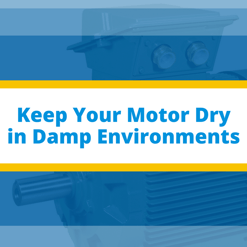 Along with heat, dust and poor lubrication, moisture is one of the leading causes of motor failure. Compared to installations in dry areas, electric motors get an instant slump in their operating lives as soon as they’re set-up in a damp area. For instance, when a warm motor shuts down, it sucks in cool air, which naturally would contain moisture due to the location. This leads to condensation droplets that are absorbed by the insulation, leading to corrosion of the windings. Furthermore, motors that are operated intermittently are at greater risk since they can accumulate moisture and with the passage of time deteriorate a motor’s operational life.
Along with heat, dust and poor lubrication, moisture is one of the leading causes of motor failure. Compared to installations in dry areas, electric motors get an instant slump in their operating lives as soon as they’re set-up in a damp area. For instance, when a warm motor shuts down, it sucks in cool air, which naturally would contain moisture due to the location. This leads to condensation droplets that are absorbed by the insulation, leading to corrosion of the windings. Furthermore, motors that are operated intermittently are at greater risk since they can accumulate moisture and with the passage of time deteriorate a motor’s operational life.
Open Drip-proof Motors
Open Drip-proof Motors aren’t designed for wet environments but due to its lower initial cost, preferred by equipment manufacturers. If an open drip-proof motor is in place, keep the following practices in mind:
- Rain, snow, fog or any other moisture accumulating element should be prevented from getting into the motor. Placing a shelter over the motor can help with this, however you should be sure not to block all the airflow.
- Open drip-proof motors are designed to be mounted in a certain way so that they can deflect any water trying to get in. Therefore, during the installation of such motors one should be sure not to change the position of the end housings relative to the base of the motor. Otherwise, the louvers will form a funnel effect, providing a direct passage not only to moisture but to dirt and debris as well, into the motor.
Nonetheless, open drip-proof motors shouldn’t be preferred for external use, and in case of failure replaced by an appropriate shielded motor.
Totally Enclosed Fan-Cooled Motors
These motors are designed for outdoor operations, especially in high-moisture areas. Weep holes at the bottom of the end housings make sure condensation as well as other damp accumulations have sufficient drainage points. These motors are often mounted in unconventional positions, e.g. vertical base, horizontal shaft, etc. Doing so displaces the weep holes by 90 degrees limiting their operations as drainage systems for moisture.
If a motor is mounted in an unusual position and it is prone to moisture accumulation, then the key is to ensure a secondary outlet. The weep holes should then be repositioned to the lower point through drilling so that the motor’s life can be safeguarded. It is important that the electrician/worker should be careful during the drilling process, not to damage the windings in any way.
Intermittent motor operations can lead to failure because large swing in temperature due to accumulated moisture. In order to reduce such episodes:
- Use internal heater such as cartridge or silicon-rubber strip heaters to make sure the inside of a motor is moisture free. Such heaters should be keep the inside of a motor 5 – 10 degrees Fahrenheit higher than the surrounding air. This would prevent condensation as well as any other moisture source from making its way into the motor’s insulation.
- Another way is “trickle heating”, which is supplying low-voltage, single-phase power to the motor windings during rest. This results in small amount of heat losses that keep the windings, rotor and shaft dry.
Hazardous Location Motors
Among all the different types of motors, these motors are extremely difficult to safeguard from a damp environment. The difficulty in protecting these motors is mainly because of their design, which is primarily to protect the motor from hazards such as explosions. The joints between end housings and frames cannot be sealed and weep hole cannot be used. This results in severe limitations.
One way to tackle this issue is using specially designed breather drains that provide an alternate channel for moisture to drain without effecting the motor’s hazard shielding features. Otherwise, space heaters may be used in the vicinity of these motors to keep them a few degrees above room temperature.
Interested in learning more? Visit our website www.premierautomation.com, or talk to one of our specialists today.




